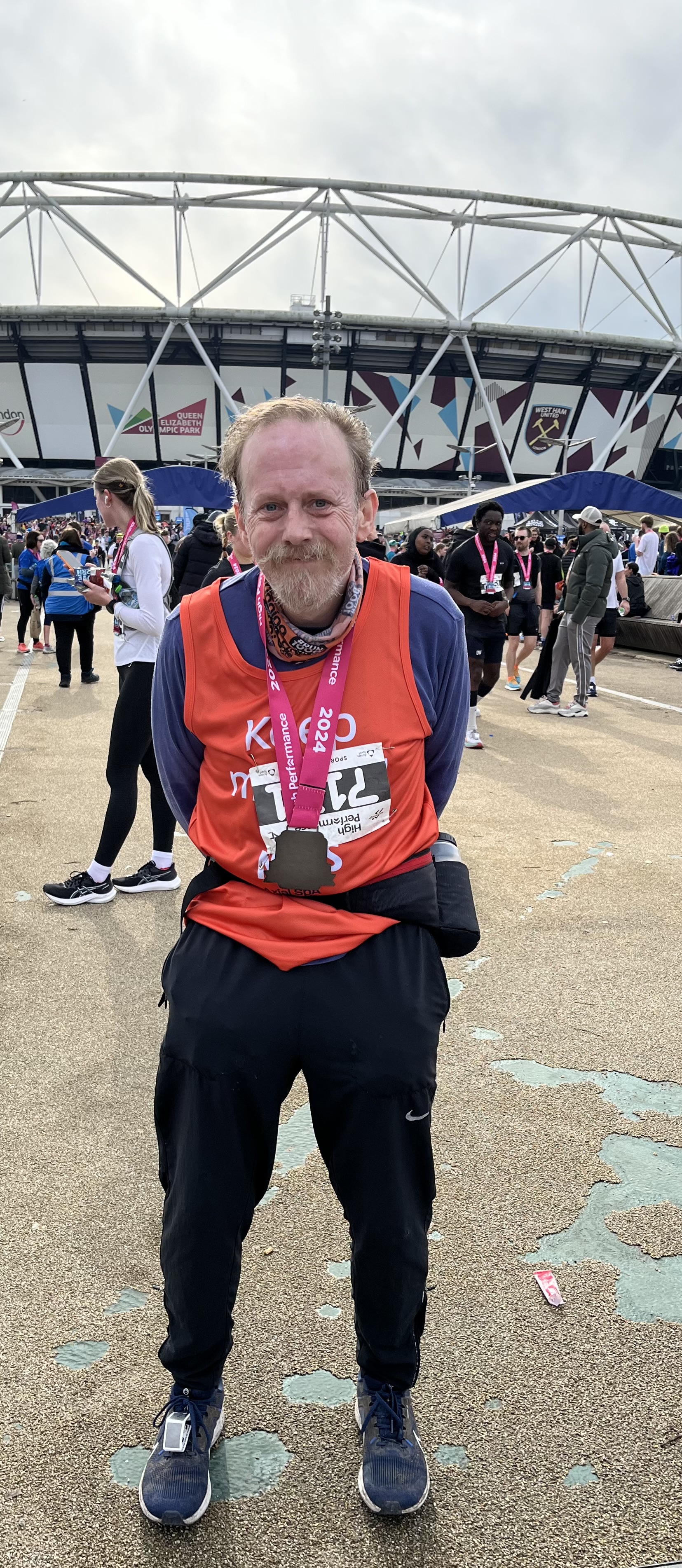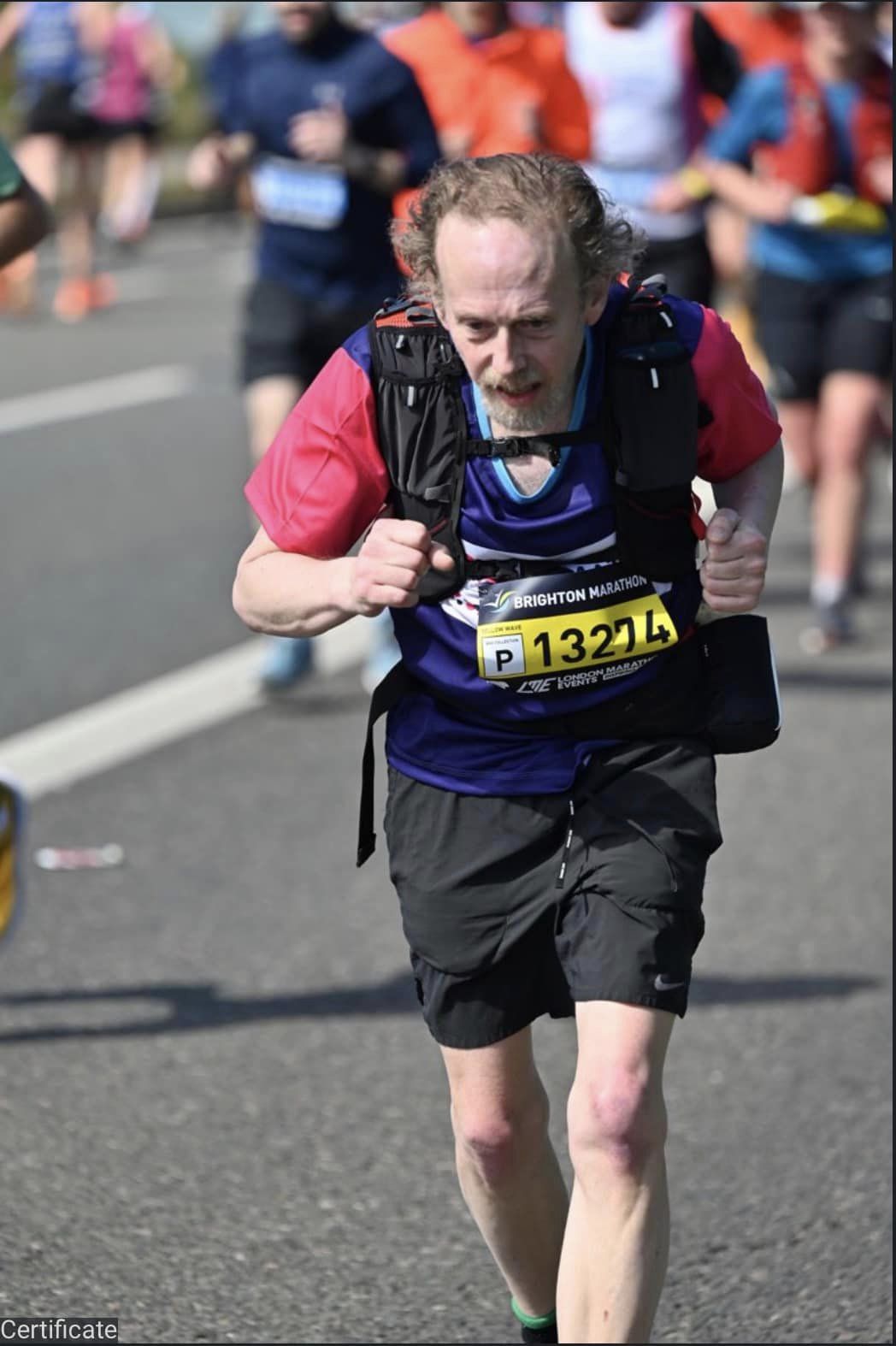“Running gives me the freedom I yearn for and most importantly it reminds me that my condition cannot have control over me.”
After 5 years of feeling ignored and misled by GPs, living in constant pain in his back, James was finally diagnosed with axial SpA. This year, despite fusion in his neck and spine, he completed the Queen Elizabeth II Olympic Park Half Marathon and raised £210 for NASS.
Here’s his story.

In 2002, I decided to run the London Marathon. I was 27 at the time. I trained and successfully completed it. While I was training, I began to feel twinges in my spine that didn’t feel right, but I didn’t pay much thought to it at the time. It was initially passed off as the side effects of having run the London Marathon.
I opened the door, and before I had even sat down the doctor said, “Do you realise that you have ankylosing spondylitis?”.
My back issues continued for a long time after that, and I was constantly visiting my GP. I was referred to various hospitals in the Southeast London area. From 2002 to 2007, my pain and back issues got progressively worse and every time that I went to the doctors or was referred to a hospital, nothing was found. The GP kept saying that it was in my head, but I was adamant that there was an issue. This went on for years with no results.
One day, I decided to have a private consultation. I opened the door, and before I had even sat down the doctor said, “Do you realise that you have ankylosing spondylitis?”. After 5 years of being ignored and mislead, I was ecstatic that someone finally believed me. I had a specific blood test and an X Ray. The following week I was referred to a rheumatologist at Lewisham Hospital.
“At my worst I was bedridden, unable to exercise and in constant pain.”
I continued seeing my rheumatologist and I was prescribed different pain killers to manage the pain. At my worst I was bedridden, unable to exercise and in constant pain. I somehow managed to function at a very basic level but it was far from great. For a long period of time, I couldn’t even run.
By this time the fusing in my spine began to take its toll on me, and I discovered that I had also developed sciatica. There came a point where I knew that the pain wouldn’t go, so I had to learn to live with it and find a way to function. I began creating a mental focus to run through the pain. In 2011, I completed my second London Marathon. I was on the maximum amount of pain medication.
“I refuse to allow axial SpA to get the better of me.”
By 2015, I met the criteria to try biologic therapy. Biologic therapy has changed my life and enabled me to run even greater distances and take on my third in-person Marathon, which I achieved in 2023.

However, I still live in a lot of pain daily, and my back and neck have completely fused together. Despite all of this, I refuse to allow axial SpA to get the better of me. I stretch, I walk, and I run. Running gives me the freedom I yearn for and most importantly it reminds me that my condition cannot have control over me.
Here are James’ top tips for anyone with axial SpA looking to get into running:
1. Stretch!
I need to stretch a lot, either through yoga or daily stretches. I have advanced axial SpA and I’ve found chair yoga incredible. You can find sessions on YouTube. I have a Peloton App and regularly use their 10- or 15-minute chair yoga.
2. Do some lower impact activity
I find walking and swimming amazing ways of ensuring that your body is getting movement without the strain.
3. Keep moving
It took 5 years to get my diagnosis and as time went on, my activity levels decreased and pretty much stopped. Just keep moving.
4. Find what works for you
I have found that being a runner (a road runner at that) is a very unforgiving activity, but I just love to run. Because I had had a love and passion running, I found a way to make it work for me.
5. Work closely with your rheumatology department
When I got back into running again (after an unrelated health issue) I liaised with my rheumatology department every step of the way. I have had phenomenal success with my rheumatology team! Once they realised that I was never going to ease off the running, they found a way to make it work for me.
6. Speak to your physio team
When I needed an extra bit of support, I spoke to my physio team. They were excellent at showing me new and different stretching exercises to help and support my back during exercise.
7. Don’t give up
Never give up. Just keep going. I am not competing with other people; I just need to go at my own pace. We all have bad days, I embrace those, and learn for the future. I don’t listen to negativity. As a runner with axial SpA, I have borne the brunt of many horrible comments about my posture I just do not listen to them and keep going!
8. Rehydrate
I am a long-distance runner and can happily push out 15, 30, 25 mile runs but I always carry my own liquids with me. Rehydration is the key to help and support me during prolonged activity.
9. Set yourself a target
I set myself a target, and just don’t quit until I get there. I had two targets:
- To run a sub-1h 10K like I used to do in my 20s (pre-axial SpA), some 25 plus years ago. It took me 5 races to reach that target and I have managed to keep it this way ever since.
- I challenged myself to run a marathon quicker than my first marathon in 2002. I last ran the London Marathon in 4h 50min, and I completed the Brighton Marathon 2023 in 4h 41min. Do not dismiss the power of self-belief, and trust and focus on your own abilities.
Thank you James for choosing to support NASS. Every penny you raise helps provide information and support to people with axial SpA with the help of NASS.
Inspired by James’ story?
Click here to sign up to a challenge event near you.